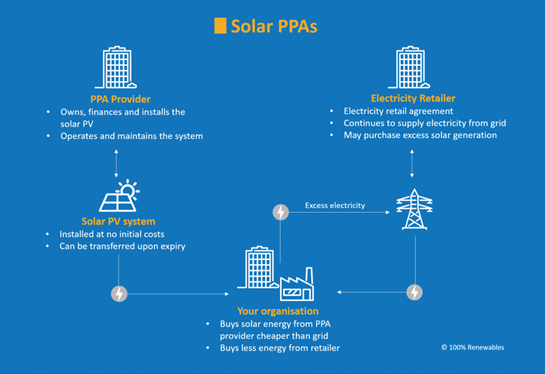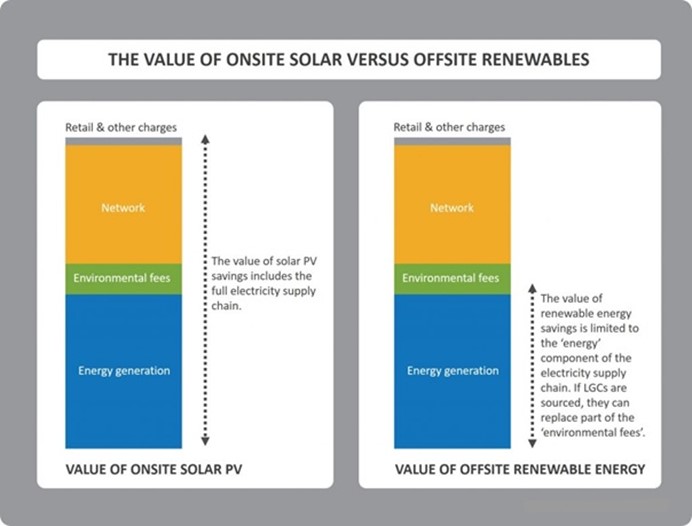Put simply a PPA is an agreement between an independent power generator (or vendor) and a purchaser (often called the ‘off-taker’) for the sale and supply of energy. They can be used for the supply of any type of energy, but in more recent times have often been used for the supply of renewable energy such as through solar panels or wind generators.
How does a PPA work?
A PPA can take on two general forms. In a physical PPA, energy is physically supplied and sold directly to the purchaser. The power generator is usually not connected to the wholesale National Energy Market (NEM). A virtual or synthetic PPA involves two distinct agreements which operate in parallel.
Unlike a physical PPA, the energy is not physically supplied and sold directly from the generator to the purchaser. Instead, the generator must connect to the NEM, where the purchaser is supplied energy through a contract with an authorised market retailer. At the same time a separate agreement, often taking the form of a ‘contract-for-differences’ is agreed between the generator and the purchaser to guard against fluctuations in the spot price for electricity which will be reflected in the retail contract. This means that, in effect, the energy and relevant renewable energy certificates are provided to the purchaser at a ‘fixed price’.
A behind the meter PPA is a physical PPA with the solar generation units installed behind a customer’s meter. Behind the meter PPAs are advantageous as they allow for the sale of electricity without the need for the use of the grid.

There are three parties to consider; your business, the PPA provider and your electricity retailer.
- 1. PPA provider is the installer, owner, operator and maintainer of the solar PV on your premises. The PPA provider sells you the electricity generated from solar for an agreed price and duration, typically ten years. At that time there may be options for you to purchase the panels, for the PPA provider to remove them, to extend the agreement, or to renew a PPA agreement with a new system.
- 2. Your business (purchaser, or off-taker) is the buyer of electricity from the solar panels on your premises. You buy this electricity for an agreed price, lower than your grid electricity price.
- 3. Your electricity retailer continues to supply electricity from the grid, likely to cover most of your demand, and you will continue to receive a bill from them. Your retailer may agree to purchase excess solar energy generation for a feed-in-tariff. As a result, there will be two electricity bills, one from your PPA provider and one from your electricity retailer.
What are solar PPA benefits?
There are many advantages to procuring an onsite solar PPA, which include:
- No upfront cost – the PPA provider bears the costs associated with the purchase and installation of the solar panels.
- No on-going operation and maintenance costs – the PPA provider is responsible for operation and maintenance of the solar panels.
- Helps achieve environmental goals – you can use the electricity generated from the solar panels to reduce your carbon emissions or to meet your renewable energy targets.
- Lower cost of electricity – the solar PPA price should be lower than the cost of grid electricity and may include a process to confirm that this is the case and adjust over time.
- Monitoring of and guaranteed performance – the PPA provider monitors and may guarantee the performance of the solar panels as part of the agreement.
- Potential for expansion and battery storage – a PPA could potentially be expanded to include new solar panels and battery storage. Thus, savings from solar could grow over time with no capital outlay and continued cost savings compared with grid power prices.
- Wholesale price uncertainty – A PPA allows the organisation to lock in a price for electricity over an extended period. The purchaser can benefit from not being subject to the price fluctuations of the wholesale energy market. On the other hand, this may lock the organisation into a price higher than it would otherwise pay.
What are solar PPA risks?
There are also potential risks associated with onsite solar PPAs, which include:
- More expensive over the life of the agreement – although there is minimal upfront cost for a solar PPA, the total cost over the life of the agreement will be higher than simply purchasing the system at the start.
- Duration of solar PPA – many PPAs are for 7 to 15 years, which may be longer than your business can commit unless there is long-term certainty of remaining at the same location.
- Expansion or change – future development adjacent to or on your facility, or to fixtures attached to your roof may alter the performance of or weaken the case for a solar PPA.
- Costs to make your property solar-ready – You may incur additional costs such as electrical works, cabling and roof repairs when installing solar panels.
- Quality of panels – you may have less choice in solar panel and inverter technologies under a PPA.
How do I compare the value of onsite versus offsite renewables for my business?
Fluctuating electricity prices, falling costs for renewable energy technologies and an elevated focus on satisfying ESG criteria have led many businesses to look at ways they can reduce their energy costs by installing solar panels ‘onsite’, or sourcing renewable energy ‘offsite’ by building offsite solar farms or buying renewable energy via purchase power agreements (PPA). So what approach offers the best value for money?
Onsite or ‘behind-the-meter’ solar installations
For many businesses installing solar panels is an excellent fit, as operating hours and sunshine hours are often the same. That means that the energy generated by solar panels can be used instantly instead of buying electricity from the grid.
The electricity supply chain is made up of energy generation, transmission & distribution, electricity market and environmental costs. When you generate solar energy on your own site, this offsets all of these costs. In essence, you are replacing the whole electricity supply chain with every kWh of energy your solar installation generates, so the value of each kWh saved is high. For a small business the value of each kWh of solar energy generated may be 25¢/kWh, and for large businesses, it is typically 12-15¢/kWh. This is illustrated on the left-hand side of Figure 1 below.
When batteries become cheaper, businesses with more roof space, intermittent energy demand and/or operations outside of sunshine hours will be able to install more solar panels with batteries and achieve this same value for their savings.

Offsite renewable energy
Some businesses are considering building their own renewable energy generation system – typically a solar farm – or want to buy renewable energy from their retailer at the same or lower cost than current rates. In either case, the renewable energy generator that you source electricity from is ‘offsite’, and the electricity generated is delivered to the grid first. From the grid, the renewable power is distributed to your business premises in the same way regular power is delivered.
Because the energy still goes through the grid, you will still pay all the distribution and electricity market costs, as well as some or all of the environmental charges. Savings will be achieved where:
- The cost of buying the renewable energy generated is less than the cost of buying ‘regular’ power from fossil-fuel generators, and where
- The cost of Large-Scale Generation Certificates (LGCs) from the offsite plant is less than these costs when passed through on your electricity bill by your retailer.
This is illustrated on the right-hand side of Figure 1 above.
So which approach offers better value?
Onsite and offsite renewable energy strategies are complementary and can both be pursued by business.
Offsite renewable energy generation can deliver small cost savings compared with buying ‘standard’ electricity from your electricity retailer. However, you may be able to source most or all of your electricity from renewables. This will provide tangible benefits to satisfying corporate ESG requirements which in turn effects many parts of the business in this new world of elevated focus on climate change.
Onsite solar, and in future batteries, will deliver a much better return on investment because savings are across the whole electricity supply chain, but for most businesses the percentage of electricity that can be generated in this way is small, usually from 5-30% of total consumption.
By 2050, we believe renewables will power the grid, and that all businesses will run on 100% clean energy. However, reducing costs will be an ongoing focus for businesses. Maximising the use of onsite roof and land space for solar arrays and battery storage will improve your bottom line and provide clean energy at the lowest cost.
Each solar project is different, and each project needs to be evaluated on its own merit.

